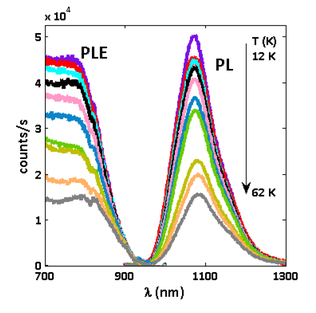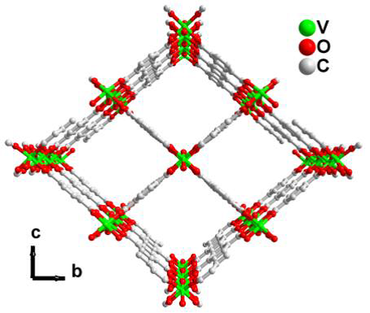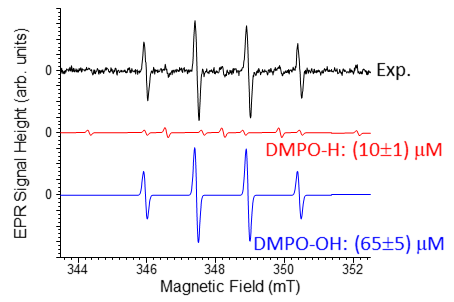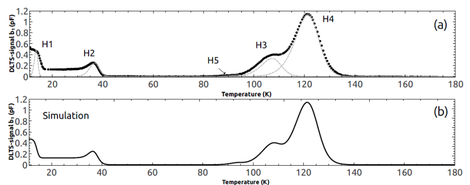Research
Defects research
Any deviation from the perfectly periodic crystal structure of a solid can be regarded as a defect. We study the geometric and electronic structure of defects in semiconductors and wide bandgap materials in order to explain their effects on electronic, electric and optical material properties and device performance.
Defects are investigated through the electronic energy levels they introduce in the bandgap of the material, through their vibrational spectra (local vibrational modes (LVM)) and their electron magnetic resonance (EPR, ENDOR) spectra.
The main characterization techniques used in our research are
- Fourier-transform infrared spectroscopy (FTIR)
- Deep-level transient spectroscopy (DLTS)
- Electron paramagnetic resonance (EPR)
Information on the equipment can be found under Facilities.
Research topics
- Point and extended defects (dislocations, interface defects) in group IV and III-V semiconductors for (opto)electronics
- Materials for thin-film solar cells
- Radiation-induced defects and radiation dosimetry materials
- Paramagnetic dopants and radicals in metal- and covalent organic frameworks
- Plasma-induced radicals
Current and recent projects
-
Wide-range multi-purpose Fourier-Transform Infrared spectrometer for Materials, Archaeological and Geological Research (FT-IMAGER)
Via this Hercules-1 (FWO) project (AUGE/13/16), a combined Fourier-Transform Infrared spectrometer and microscope operating in the 10 cm-1 – 15000 cm-1 wavenumber range has become available at UGent. This instrument is used in a very broad range of research topics of the promoters and catalyzes new scientific collaborations within Ghent University, with other Universities and research institutions.
The research website of this project can be found here.
Promoters: Henk Vrielinck, Klaartje De Buysser, Johan Lauwaert, Stephen Louwye, Kenneth Mertens, Gűnther Roelkens, Peter Vandenabeele and Pascal Van Der Voort.
One particular research theme we have focused on within this project, in collaboration with the COMOC research group and the CMM, is characterization of the vibrational modes of metal-organic frameworks, with special attention for the low-frequency modes in the far infrared.
SELECTED PUBLICATIONS- Attenuated total reflection (ATR) micro-Fourier transform infrared (Micro-FT-IR) spectroscopy to enhance repeatability and reproducibility of spectra derived from single specimen organic-walled dinoflagellate cysts
Pjotr Meyvisch (UGent) , Pieter Gurdebeke (UGent) , Henk Vrielinck (UGent) , Kenneth Neil Mertens, Gerard Versteegh and Stephen Louwye (UGent)
(2021) APPLIED SPECTROSCOPY.
- Fructosamine-3-kinase as a potential treatment option for age-related macular degeneration
Sander De Bruyne, Caroline Van den Broecke (UGent) , Henk Vrielinck (UGent) , Samira Khelifi (UGent) , Olivier De Wever (UGent) , Ken Bracke (UGent) , Manon Huizing, Nezahat Boston, Jonas Himpe (UGent) , Marijn Speeckaert (UGent) , et al.
(2020) JOURNAL OF CLINICAL MEDICINE. 9(9).
- Elucidating the vibrational fingerprint of the flexible metal-organic framework MIL-53(Al) using a combined experimental/computational approach
Alexander Hoffman (UGent) , Louis Vanduyfhuys (UGent) , Irena Nevjestic (UGent) , Jelle Wieme (UGent) , Sven Rogge (UGent) , Hannes Depauw (UGent) , Pascal Van Der Voort (UGent) , Henk Vrielinck (UGent) and Veronique Van Speybroeck (UGent)
(2018) JOURNAL OF PHYSICAL CHEMISTRY C. 122(5). p.2734-2746
- Attenuated total reflection (ATR) micro-Fourier transform infrared (Micro-FT-IR) spectroscopy to enhance repeatability and reproducibility of spectra derived from single specimen organic-walled dinoflagellate cysts
-
Point and extended defects in semiconductors for electronics
Point and extended defects in semiconductors have a strong influence on the lifetime of minority charge carriers and typically lead to inferior device properties like increased leakage current or decreased carrier mobility. However, such defects may be difficult to avoid in heteroepitaxial layer growth or thermal processing steps, commonly used in present-day device fabrication. DLTS is ideally suited to identify and quantify known defects and to assess the carrier trapping properties of the defects.
In the FWO research project “Study of the properties of intrinsic point defects in monocrystalline germanium” (promoters: Freddy Callens, Eddy Simoen, Jan Vanhellemont, Henk Vrielinck), we investigated intrinsic quenced-in defects in Ge after thermal anneal. This research revealed Cu as a very common contaminant. It also lead to new insights on the DLTS spectra of semi-deep-level defects (capture kinetics, emission mediated by “thermal-photo-ionization”). The results of this project are summarized in the PhD thesis of dr. Siegfried Segers, title: Study of point defects in monocrystalline germanium.
DLTS spectrum of samples quenched in silicone oil (tQ=60 min, TH=650°C; VR=-1V, VP =-0.2V, tW=512 ms) (a) experiment and (b) simulation. H1 and H4 have been identified as acceptor defect levels of substitutional Cu in Ge.
In a collaboration between ON-Semiconductor, University of Antwerp and Ghent University (VLAIO – Baekeland), we currently investigate trapping states at SiC/SiO2 interfaces (“Electrical and physical characterization of trap states at the SiC/gate dielectric interface in SiC metal-oxide-semiconductor field-effect transistors”, promoters Peter Moens (ON Semiconductor), Sofie Cambré (UAntwerp), Henk Vrielinck (UGent))
SELECTED PUBLICATIONS
Other current research on electrically active defects in group-IV and III-V semiconductors includes alloy group-IV semiconductors (Ge1-xSnx, Si1-xGex).- Analysis of semi-insulating carbon-doped GaN layers using deep-level transient spectroscopy
H.Y. Wang, P.C. Hsu, M. Zhao, E. Simoen, S. De Gendt, A. Sibaja-Hernandez, J.Y. Wang.
(2021) J. Appl. Phys. 130 (20) Article No. 205701.
- Impact of band to band tunnelling in In0.53Ga0.47As tunnel diodes on the deep level transient spectra
S Gupta, Eddy Simoen (UGent) , R Loo, Q Smets, AS Verhulst, Johan Lauwaert (UGent) , Henk Vrielinck (UGent) and M Heyns
(2018) APPLIED PHYSICS LETTERS. 113(23).
- Electrical properties of extended defects in strain relaxed GeSn
Somya Gupta, Eddy Simoen (UGent) , Roger Loo, Yosuke Shimura, Clement Porret, Federica Gencarelli, Kristof Paredis, Hugo Bender, Johan Lauwaert (UGent) , Henk Vrielinck (UGent) , et al.
(2018) APPLIED PHYSICS LETTERS. 113(2).
- Analysis of semi-insulating carbon-doped GaN layers using deep-level transient spectroscopy
-
Identification of electrically active defects in materials for solar cells
The purpose of this project funded by the Ghent University Special Research Fund is to identify defects in the absorber layer of solar cells, which limit the efficiency of the cells. The research focuses on thin film solar cells, mainly with CuIn1-xGaxSe2 absorber. Defects in solar cells and absorber bulk materials are characterized electrically using Deep-Level Transient and Admittance spectroscopy, optically via Fourier-Transform infrared and Infrared photoluminescence (PL) spectroscopy and structurally. The results of this research help directing the optimization of solar cells of this type.
Within this recent project we established that the so-called N1 DLTS signal is due to a non-ideal electric contact (non-ohmic, rectifying electric contact) in the cell, rather than to point defects promoting recombination. Furthermore, solar cells with CuIn1-xGaxSe2 and Cu2ZnSnS4 absorbers were characterized, mainly using PL and PL excitation spectroscopy. This research was performed in collaboration with EMPA Zűrich and the Angstrom Solar Center of Uppsala University and led to the PhD thesis of Lisanne Van Puyvelde Electric and optical defect characterisation of Cu2ZnSnS4 and CuIn1-xGaxSe2 based thin-film solar cells.

Temperature dependence of the PL and PL excitation (PLE) spectrum of a Cu2ZnSnS4 solar cell as a function of temperature. Van Puyvelde et al. Thin Solid Films 582, p. 146-150 (2015).
Thin-film solar cells remain an active research area in the group. Currently, we are focusing on studying and analyzing the formation of secondary/ternary phases in thin-film solar cells based on chalcogenide and kesterite materials. Also within the thin-film solar cell technology, perovskite are considered as potential materials for PV application, however they show environmental stability issues when they are subjected to moisture, oxygen, light and heat. As part of our research activities, perovskite materials and solar cells devices are investigated using several characterization techniques in order to tackle these issues and explore solutions for device stability and extend their lifetime.
SELECTED PUBLICATIONS- The path towards efficient wide band gap thin-film kesterite solar cells with transparent back contact for viable tandem application
Samira Khelifi (UGent) , Guy Brammertz, Léo Choubrac, Maria Batuk, Sheng Yang (UGent) , Marc Meuris, Nicolas Barreau, Joke Hadermann, Henk Vrielinck (UGent) , Dirk Poelman (UGent) , et al.
(2021) SOLAR ENERGY MATERIALS AND SOLAR CELLS 219, 110824
- Effect of Na and the back contact on Cu2Zn(Sn,Ge)Se4 thin-film solar cells: towards semi-transparent solar cells
Andrea Ruiz-Perona, Yudania Sanchez, Maxim Guc, Samira Khelifi (UGent), et al.
(2020) SOLAR ENERGY 206, 555-563.
- Wide band gap kesterite absorbers for thin film solar cells: potential and challenges for their deployment in tandem devices
Bart Vermang, Guy Brammertz, Marc Meuris, Thomas Schnabel, Erik Ahlswede, Leo Choubrac, Sylvie Harel, Christophe Cardinaud, Ludovic Arzel, Nicolas Barreau, Joop Van Deelen, Pieter-Jan Bolt, Patrice Bras, Yi Ren, Eric Jaremalm, Samira Khelifi et al.
(2019) Sustainable Energy & Fuels 3 (9), 2246-2259
- The path towards efficient wide band gap thin-film kesterite solar cells with transparent back contact for viable tandem application
-
Radiation-induced defects and radiation dosimetry materials
In materials like hydroxy-apatite, alanine, various sugars, lithium formate, … stable radicals are produced when they are irradiated with ionizing radiation (alpha, beta, gamma, X-rays). The radiation dose such materials received can be deduced from the intensity of the EPR spectrum of these stable radicals. The sensitivity of EPR dosimeter systems is at best in the order of a few cGy (centigray = 0.01 Gy). They are thus considerably less sensitive than luminescence based dosimeters (based on thermoluminescence, optically stimulated luminescence, radio-photoluminescence, …). In the latter type of dosimeters, trapped-electron and -hole states created upon radiation exposure can also be paramagnetic, and may be structurally identified using EPR spectroscopy.
In the past few decades radiation-induced radicals have been investigated in a large number of solid state sugars and sugar phosphates. The original interest of this research was in dosimetry and irradiated food detection. However, these crystalline solids also serve as models for studying radiation damage to DNA.
In the project “Electron Nuclear Double Resonance (ENDOR) approach for studying radiation damage in DNA” an EPR and ENDOR study of radiation-induced radicals on DNA samples was attempted, aiming to be comparably successful as for sucrose, the most thoroughly EPR-investigated sugar. This would provide the most direct way to determine the precise role of sugar radicals in radiation damage to DNA. Preparative work in this project involved determining principal values and directions of g and hyperfine tensors of radicals of sucrose and alanine from powder EPR and ENDOR spectra. A critical evaluation was made, whether the spin Hamiltonian information that could be extracted from field-dependent ENDOR (field-frequency ENDOR) spectrosocpy is sufficient to lead to unique radical defect models, based on comparison with density functional theory calculation of g and hyperfine tensors for radicals. The results of this project are bundled in the PhD thesis of Jevgenij Kusakovskij.
Current research activities in this line have shifted towards identifying electron- and hole-traps in inorganic phosphor dosimeter materials, like LiF:Mg,Cu,P and Ba2SiO4:Eu.SELECTED PUBLICATIONS
- Realizing simultaneous X-ray Imaging and dosimetry using phosphor-based detectors with high memory stability and convenient readout process
Zetian Yang , Jieqi Hu , David Van der Heggen , Ang Feng , Hairong Hu , Henk Vrielinck , Philippe Smet and Dirk Poelman
(2022) ADVANCED FUNCTIONAL MATERIALS. 32(31).
- Designing photochromic materials with large luminescence modulation and strong photochromic efficiency for dual-mode rewritable optical storage
Zetian Yang , Jiaren Du, Lisa Martin , Ang Feng , Ewoud Cosaert , Bo Zhao , Wanlu Liu , Rik Van Deun , Henk Vrielinck and Dirk Poelman
(2021) ADVANCED OPTICAL MATERIALS. 9(20).
- ENDOR-induced EPR of disordered systems : application to X-irradiated alanine
Jevgenij Kusakovskij (UGent) , Kwinten Maes (UGent) , Freddy Callens (UGent) and Henk Vrielinck (UGent)
(2018) JOURNAL OF PHYSICAL CHEMISTRY A. 122(6). p.1756-1763
- Realizing simultaneous X-ray Imaging and dosimetry using phosphor-based detectors with high memory stability and convenient readout process
-
Metal and covalent organic frameworks: paramagnetic dopants and identification of radical reaction pathways
Collaboration with COMOC (dept. Chemistry)In the FWO project “In situ Electron Magnetic Resonance study of coordinative and structural transformations in paramagnetically doped Metal Organic Frameworks”, the EMR and COMOC teams of Ghent University aimed to gain insight in the catalytic activity and structural flexibility of metal-organic frameworks (MOFs). These porous network structures, built up from metal centres and organic linkers, allow tayloring structure, pore size and shape to desired functionality. They have potential applications in diverse fields (adsorption, catalysis, separations, ...). Elementary reaction steps during catalysis and structural transformations were investigated on a selection of Al(III)-OH-, isostructural V(IV)=O-MOFs with wine-rack topology (see figure), and their mixtures.
The research within this project resulted in the PhD theses of Irena Nevjestic and Hannes Depauw. Follow-up research led to the PhD thesis of Kwinten Maes.
Perspective view of MIL-47 (VIV=O(BDC))
More recently, EPR has also been used to elucidate radical-mediated steps in the catalytic reaction mechanisms of and covalent triazine frameworks, covalent organic frameworks and porous organic polymers.
SELECTED PUBLICATIONS
- Identification of vanadium dopant sites in the metal-organic framework DUT-5(Al)
Kwinten Maes, Lisa Martin, Samira Khelifi , Alexander Hoffman, Karen Leus, Pascal Van Der Voort, Etienne Goovaerts, Philippe Smet, Veronique Van Speybroeck, Freddy Callens, Henk Vrielinck
(2021) PHYSICAL CHEMISTRY CHEMICAL PHYSICS. 23(12). p.7088-7100
- Elucidating the promotional effect of a covalent triazine framework in aerobic oxidation
Sara Abednatanzi , Parviz Gohari Derakhshandeh , Pieter Tack , Francesco Muniz Miranda , Ying-Ya Liu, Jonas Everaert , Maria Meledina, Flore Vanden Bussche, Laszlo Vincze , Christian Stevens , Veronique Van Speybroeck, Henk Vrielinck, Freddy Callens, Karen Leus, Pascal Van Der Voort
(2020) APPLIED CATALYSIS B-ENVIRONMENTAL. 269.
- Sensing the framework state and guest molecules in MIL-53(Al) via the electron paramagnetic resonance spectrum of VIV dopant ions
Irena Nevjestic , Hannes Depauw , Peter Gast, Pieter Tack , Davy Deduytsche , Karen Leus , Melissa Van Landeghem, Etienne Goovaerts, Laszlo Vincze , Christophe Detavernier , Pascal Van Der Voort, Freddy Callens , Henk Vrielinck
(2017) PHYSICAL CHEMISTRY CHEMICAL PHYSICS. 19(36). p.24545-24554
- Identification of vanadium dopant sites in the metal-organic framework DUT-5(Al)
-
Reactive oxygen species produced by plasma-treatment
Collaboration with research unit plasma technology (dept. Applied Physics – faculty of Engineering and Architecture)
Non-thermal plasma treatments increasingly find their way in materials and biomedical engineering, facilitating materials synthesis (promoting certain polymer reactions, e.g.), wound healing or cancer therapy. Highly reactive oxygen and/or nitrogen radicals are expected to play an important role in the beneficial effect of plasma treatments. These radical species have very short lifetimes. In order to allow their detection, quantification and identification with EPR, spin traps (e.g. DMPO) need to be used. Spin trap molecules can trap specific radicals, increasing the lifetime of the radical adduct to the order of minutes or even hours (several order of magnitude longer than the lifetime of the free radical). Analysis of the resulting EPR spectra can also reveal the identity of the trapped radicals. However, spin trapping remains an indirect method for detecting radical species and results need to be interpreted with caution, since addition of a spin trap may complicate (change!) reaction chemistry.

EPR spectrum of Ar-plasma treated water solution with 0.1 M DMPO. The EPR spectrum is a superposition of the -OH· and -H· radical adducts to DMPO. The EPR signal intensities are translated to concentrations via an intensity calibration with a TEMPO (stable radical) concentration series.
Our current collaboration involves determining the oxygen-related radicals produced by He and Ar plasma, created above or inside, water. Spin-trapping with DMPO reveals that -OH· and -H· radicals are formed in concentration ratios, depending on the details of the plasma treatment.
FIRST RESULTS
- Comparative study of short-lived radical species generated in in-plasma and subjacent-plasma treated water
Parisa Shali , Rouba Ghobeira , Mathieu Willems, Rino Morent , Henk Vrielinck and Nathalie De Geyter
Poster presented at the 29th Benelux EPR Society meeting in Brussels (2022)
- Comparative study of short-lived radical species generated in in-plasma and subjacent-plasma treated water
